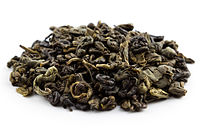
Photo from wikipedia
This study selected common processing methods for orthodox black tea and investigated changes in the levels of Nε-(carboxymethyl)lysine (CML), Nε-(carboxyethyl)lysine (CEL), lysine, and polyphenols during each processing stage and using… Click to show full abstract
This study selected common processing methods for orthodox black tea and investigated changes in the levels of Nε-(carboxymethyl)lysine (CML), Nε-(carboxyethyl)lysine (CEL), lysine, and polyphenols during each processing stage and using different parameters of each processing step. The effects of epicatechin gallate, epigallocatechin, epigallocatechin gallate, and gallic acid on the levels of CML, CEL, fructoselysine, glyoxal, and methylglyoxal were investigated by chemical model systems study under black tea processing conditions. In tea samples, CML and CEL levels significantly increased during drying (could reach 51.8 and 8.7 μg/g tea, respectively), while natural withering and extensive rolling and fermentation times facilitated the formation of CML and CEL by altering the substrate concentrations and the cellular structure of tea leaves to be dried. The results of model systems (containing lysine, glucose, and fructose) indicated that polyphenols were able to enhance the production of CML and CEL, and the levels of CML and CEL increased 1.2-3.2- and 1.6-3.5-fold, respectively. Furthermore, the main pathways responsible for CML and CEL formation during black tea processing likely involve fructoselysine and others but not glyoxal or methylglyoxal.
Journal Title: Food research international
Year Published: 2019
Link to full text (if available)
Share on Social Media: Sign Up to like & get
recommendations!